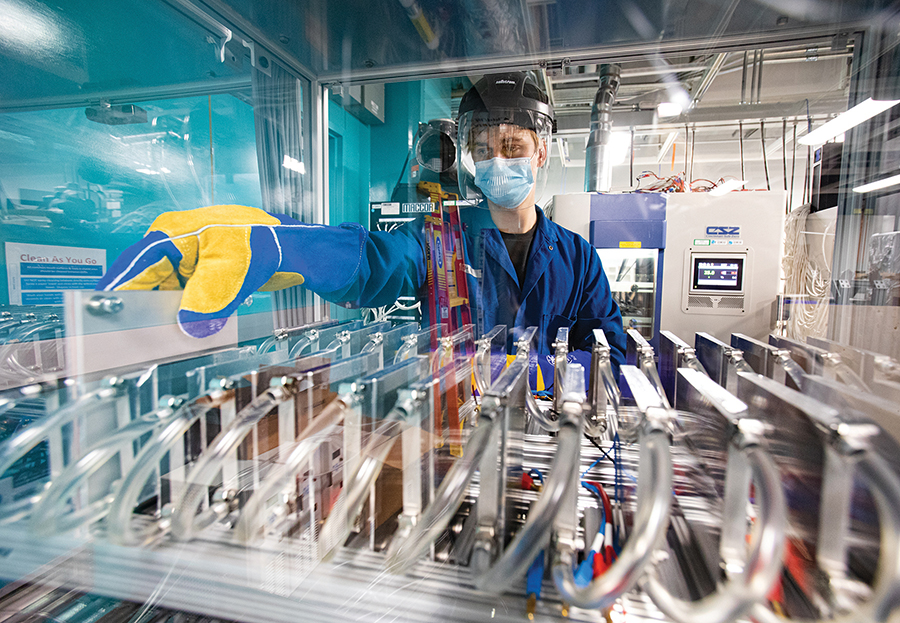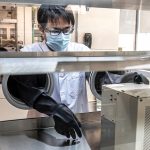
Bruis van Vlijmen demonstrates how he works inside a battery informatics lab as part of the SLAC National Accelerator Laboratory’s research efforts. Photo by Jacqueline Orrell/SLAC National Accelerator Laboratory.
California has repeatedly strengthened its commitment to reducing greenhouse gas emissions. It wants to have five million electric vehicles (EVs) on the road by 2030 and it will ban sales of new gas-powered cars and trucks by 2035.
At the heart of these moving targets is a significant statewide policy effort to fight climate change and reduce air pollution. But a lot of energy lies in avenues of EV innovation, especially on the academic research path. Universities in the Bay Area and beyond are exploring technologies that contribute to goals necessary for mass EV adoption: reduced vehicle cost and charging time, as well as increased battery range and storage.
On March 8, Stanford University scientists announced a breakthrough toward achieving these goals: they had applied machine learning to accelerate the design of new batteries and enhance their use. Published in Nature Materials, their study is part of a collaboration between Stanford, the Massachusetts Institute of Technology, the Toyota Research Institute, and the Department of Energy’s SLAC National Accelerator Laboratory.
“Ten years ago, I selected batteries as a research area where I saw promise,” said William Chueh, an investigator with SLAC who led the study. “I started working on batteries because I thought electrification would be a key step to de-carbonization, but I also took time to understand the underlying scientific challenges.”
He boiled those problems down to a need to design new chemistries for the battery, and also accelerate the pace of research and development. Chueh’s research could affect other battery-powered devices like cell phones, but the Bay Area Monitor’s interview with the Stanford professor centered on EVs.
To be fair, the EV market has a ways to go before its products are as ubiquitous as cell phones. It’s a space where innovation is happening, but growth requires meeting other challenges.
For example, California is the largest U.S. market for electric cars. But sales represent a small portion of new passenger vehicle purchases overall and buying power isn’t evenly distributed. Many consumers need subsidies to cover the EV cost and incentivize them to shift out of traditional cars, according to Oakland’s nonprofit Greenlining Institute, which provides an equity toolkit to help make cars accessible to underserved communities.
Supporting adoption is essential. Transportation accounts for more than 50 percent of California’s greenhouse gas emissions, which contribute to climate change impacts like extreme weather, poor air quality, increased wildfires, and rising sea levels.
When California announced the 2035 phase-out date for gas-powered vehicles in September — a climate-pledge car manufacturers like General Motors and Volvo have since separately committed to as well — it provided added motivation to scientists engaged in ongoing research.
Chueh and his colleagues began a while ago by learning the rules for designing better batteries, the process of which forms the basis of Stanford and SLAC’s more recent research, he said.
First, they figured out how to observe what they typically can’t set eyes on: how lithium moves inside the battery as it functions. Stanford and SLAC researchers used X-rays to understand how electrode particles release stored lithium ions during battery charging, essentially making a movie of what’s occurring inside, Chueh said. Research facilities such as Lawrence Berkeley National Laboratory’s Advanced Light Source assisted with this effort.
Second, they used that data, along with mathematical models and equations that describe the chemistry and physics of the process, in scientific machine-learning algorithms.
Applying those two data points, they realized some particles release a lot of ions immediately and quickly, while others release ions slowly or not at all. This imbalanced pattern stresses the battery, which limits its lifetime. Stanford and SLAC’s discovery has the potential to improve battery cost, storage capacity, and durability for EVs.
Meanwhile, other academics have been studying new energy sources that could power EVs and help take the stress off the electrical grid. In January, a research team at California State University, Long Beach published a study that paints a picture of alternative EV charging. The team explored the potential to find new renewable energy sources when cars are driving under a freeway overpass. The research was funded by San Jose’s Mineta Transportation Institute. “We cannot rely only on one system or another system” for power generation, said Hamid Rahai, co-author of the study. “It has to be a combination.”
Using computer simulations, Rahai and his team examined the wind load on bridge columns under a 405 Freeway overpass in Long Beach and calculated the wind energy generated when a small passenger van or SUV drives past the supports. Their calculations show it’s possible to create significant renewable electric power with a zero-carbon footprint, compared to power plants relying on fuel to generate electricity. But what’s the right approach to capture wind energy? Rahai explained one option is a diaphragm. It’s part of an electronic system that oscillates and generates a current that can be captured, regulated by electronic circuitry, and made available for public use in various applications.
Or the system could rely on a vertical axis wind turbine to grab wind energy for local power generation. But this option requires continuous wind, which could be a limitation.
Rahai said it’s also possible to place diaphragm panels in optimal locations on the bridge, which could be networked to create power. A similar approach could be used for the vertical axis wind turbines along several overpasses for significant power generation, too.
Coincidently, in a separate effort, Stanford professor Shanhui Fan is working on wireless transmission of power to EVs as they drive on highways. He built a wireless charging system that could be scaled to transmit the tens or hundreds of kilowatts of electricity that an EV would need. However, it could be a while before wireless chargers are driven into highways.
EVs will contribute to the need to grow energy supplies, although it won’t be “anything extreme or out of the ability of planners to take into account,” said Alan Jenn, assistant director at the Institute of Transportation Studies at the University of California, Davis.
About 320,000 EVs are registered in Pacific Gas & Electric’s service area, representing roughly one in every five EVs in the nation, according to the utility.
But the amount of stress an EV places on the grid could depend more on when drivers charge, Jenn said. For example, charging around 6 p.m. is a peak demand time while overnight charging is generally less burdensome to the distribution system.
California’s 2018 total energy consumption is second-highest in the nation, but fourth-lowest per capita due to its climate and energy efficiency programs, according to the U.S. Energy Information Administration.
“We’ve had pretty good policy about the grid getting cleaner and adopting EVs,” Jenn said. “There isn’t really anything yet about charging behavior and promoting cleaner, more sustainable ways of charging. That’s a big policy opportunity in the future.”
Forthcoming research could inform new policies. Jenn said he is currently contributing to a California Environmental Protection Agency research effort on decarbonizing transportation by 2045. His part is exploring EV charging at specific times. That report will be released later this year.
Cecily O’Connor covers transportation for the Monitor.

